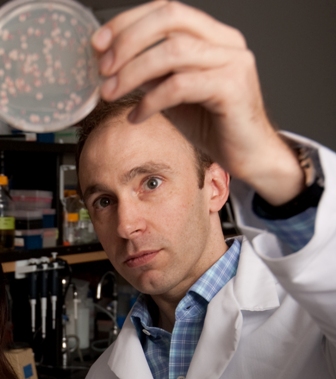
UH evolutionary biologist Tim Cooper and his team have discovered some surprising
things about gene mutations that might one day make it possible to predict the progression
of chronic disease. (Photo by Thomas Campbell)
UH evolutionary biologist Timothy Cooper and his colleagues describe their findings in a paper titled “Negative Epistasis Between Beneficial Mutations in an Evolving Bacterial Population.” The report appears June 3 in Science, the world’s leading journal of original scientific research, global news and commentary.
“The motivation for this experiment comes from wanting to understand the factors involved in the evolution of organisms to better ‘fit’ their environment,” Cooper said. “The lack of information on how mutations interact with one another has been a major gap in predicting how populations evolve. Our work shows how we can perform experiments to fill this gap, giving us a better understanding.”
Cooper and his team focused on a bacterial population that had been evolved for thousands of generations such that its fitness had increased by approximately 35 percent over its ancestor. In identifying the beneficial mutations that arose in the population and adding all possible combinations of these mutations to the ancestor strain, however, they found that combinations of mutations acted in a surprising, yet simple, way. The more mutations the researchers added, the more they interfered with each other. It was as if the mutations got in each other’s way as they all tried to accomplish the same thing.
It was found that the beneficial mutations allowing the bacteria to increase in fitness didn’t have a constant effect. The effect of their interactions depended on the presence of other mutations, which turned out to be overwhelmingly negative.
“These results point us toward expecting to see the rate of a population’s fitness declining over time even with the continual addition of new beneficial mutations,” he said. “As we sometimes see in sports, a group of individual stars doesn’t necessarily make a great team.”
Putting in about five years on this project thus far, Cooper says this work represents just the start of their efforts in trying to find general patterns that will help them predict some aspects of how populations will evolve. With improved understanding of interactions, it might be applicable not only to natural bacterial populations, but also to bacterial populations that evolve in a person.
In addition to Cooper, the UH team on this project consisted of former post-baccalaureate student Aisha Khan and postdoctoral fellow Duy Dinh. Professors Richard Lenski from Michigan State University and Dominique Schneider from Université Joseph Fourier in Grenoble, France, also contributed to this study. Funded by the National Science Foundation and the Defense Advanced Research Projects Agency, the majority of the experimental aspects of the work were done at UH.
A similar study from the lab of Chris Marx at Harvard University will be published in Science simultaneously with Cooper’s paper. Marx studied interactions between beneficial mutations arising in a different bacterium evolving in a different medium, yet also found a general trend toward diminishing returns.
Editor’s Note: High-resolution photos of Tim Cooper are available to media by contacting Lisa Merkl.
About the University of Houston
The University of Houston is a Carnegie-designated Tier One public research university recognized by The Princeton Review as one of the nation’s best colleges for undergraduate education. UH serves the globally competitive Houston and Gulf Coast Region by providing world-class faculty, experiential learning and strategic industry partnerships. Located in the nation’s fourth-largest city, UH serves more than 38,500 students in the most ethnically and culturally diverse region in the country.
About the College of Natural Sciences and Mathematics
The UH College of Natural Sciences and Mathematics, with 181 ranked faculty and approximately 4,500 students, offers bachelor’s, master’s and doctoral degrees in the natural sciences, computational sciences and mathematics. Faculty members in the departments of biology and biochemistry, chemistry, computer science, earth and atmospheric sciences, mathematics and physics conduct internationally recognized research in collaboration with industry, Texas Medical Center institutions, NASA and others worldwide.
For more information about UH, visit the university’s Newsroom.
To receive UH science news via e-mail, sign up for UH-SciNews.
For additional news alerts about UH, follow us on Facebook and Twitter.